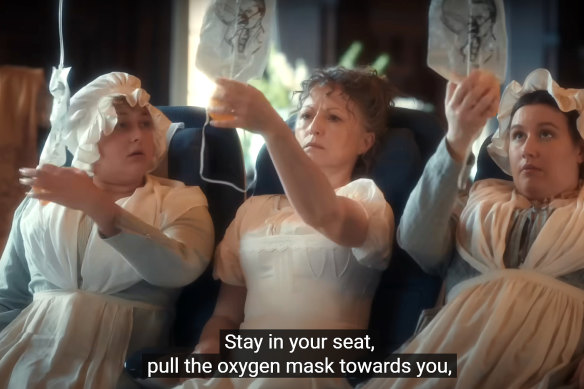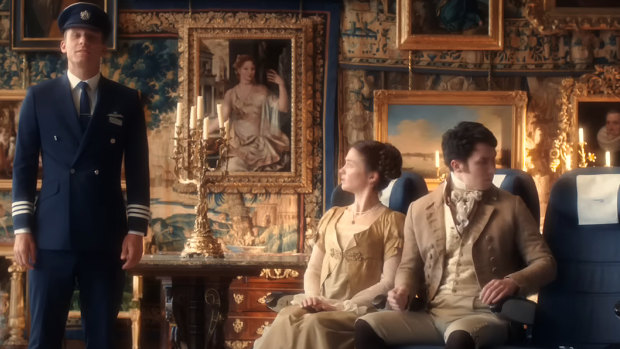Not everyone loves British Airways’ buzzy Bridgerton take
By Kelsey Ables
Passengers flying British Airways these days may be surprised to find themselves travelling not to Heathrow or Gatwick, but first to 19th-century England: complete with men on horseback, women in carriages and a corset so tight the lady might needeth an oxygen mask.
The airline’s new safety video is replete with references to British culture, and draws on the success of hit period dramas such as Bridgerton - part of a trend of airlines using increasingly cinematic safety briefings to show passengers a lot more than where they can find a life vest. British Airways said the new film is meant to “keep customers engaged with important safety messaging”.
But experts are split on whether these buzzy videos, which seem to aspire to virality, effectively share vital safety information - or just provide entertainment on top of brand or cultural awareness.

British Airways’ latest safety video plays on the popularity of period television shows.Credit: British Airways
Industry watchers trace the rise of quirky safety videos back to a playful cartoon briefing from Virgin America in 2007 and Air New Zealand’s 2009 briefing, which included crew members wearing little more than body paint as they demonstrated the “bare essentials of safety.”
In the years since, celebrities, traditional dancers, high-profile directors such as Taika Waititi, and even a K-pop group have featured in ever more elaborate productions in the name of airline safety.
Experts and officials stress that air travel is incredibly safe - the US airline system has gone 15 years without a fatal crash - and experiencing an emergency onboard is unlikely.
Embry-Riddle Aeronautical University professor Blaise Waguespack, an expert in airline marketing, said the emergence of creative safety videos reflects an attempt by carriers to break through the constant “clutter of content” on digital devices and reach distracted passengers - which is “always an issue when attempting to deliver information today”.
Some experts praised the efforts. Kevin Kuhlmann, a professor of aviation and aerospace science at the Metropolitan State University of Denver, said that for a long time mundane briefings caused regular fliers to tune out. He applauded the creative videos for bringing “the briefing back into focus.”
Macquarie University marketing professor Scott Koslow said that with these videos “you might actually get attention that you couldn’t get otherwise” and “a little bit of confusion might just be a decent price to pay to get people to look at the screen”.
Whether that attention translates to retention is a different question, though. Some airline personnel have attributed the successful evacuation of a Japan Airlines plane that collided with another aircraft earlier this year to the airline’s short and simple safety video.
The little research that exists on the topic suggests the airlines’ Hollywood glow-up may have mixed results.
One 2015 study, with 45 participants, suggests that once a viewer is watching a safety video, a humorous video is better at holding attention than a video featuring a celebrity or a standard video.
Another study from the same year, with 82 participants, found that while safety briefings that are funny or use movie themes positively affect participant’s moods, “there was a trade-off between entertainment and education” and “the greater the entertainment value, the poorer the retention of key safety messages”.
University of New South Wales professor Brett Molesworth, an author on the papers, said the research is clear that any overlap or confusion of the key safety message with entertainment or humour undermined the safety message.
Molesworth said we can only process so much information at a time, and when we encounter something entertaining or funny “it often consumes all of our working memory capacity” and airlines need to “divorce those funny bits or the entertaining bits from the key safety messages”.

Some experts fear elaborate set-ups detract from viewers ability to focus on key safety messages.Credit: British Airways
Experts say it does not help that these videos sometimes avoid even showing the aircraft. In the British Airways video, seat belts are donned on horseback and the plane exits are explained in a ballroom, while in an Air France safety video, the exit sign is transformed into an outfit worn on a catwalk at a fashion show.
Griffith University lecturer Xiaoyu Wu, who studies aviation and safety practices, said these videos might “attract your attention because they put fake seats in, I don’t know, the jungle,” but they don’t always do a good job of showing the actual safety features of the aircraft. Such videos can miss what’s important, he said, stressing that “if it’s really working, it’s preparing people” in case of an emergency.
At least one airline has made a public point of adopting that perspective. Earlier this month, Emirates released a “no-nonsense” safety video that received praise from several aviation bloggers.
“We do not have dancers breaking into song, characters from movies or celebrities trying to be funny I’m afraid,” one flight attendant says. Another says that while entertainment will be available later: “Safety always comes first.”
This article first appeared in The Washington Post
Sign up for the Traveller newsletter
The latest travel news, tips and inspiration delivered to your inbox. Sign up now.